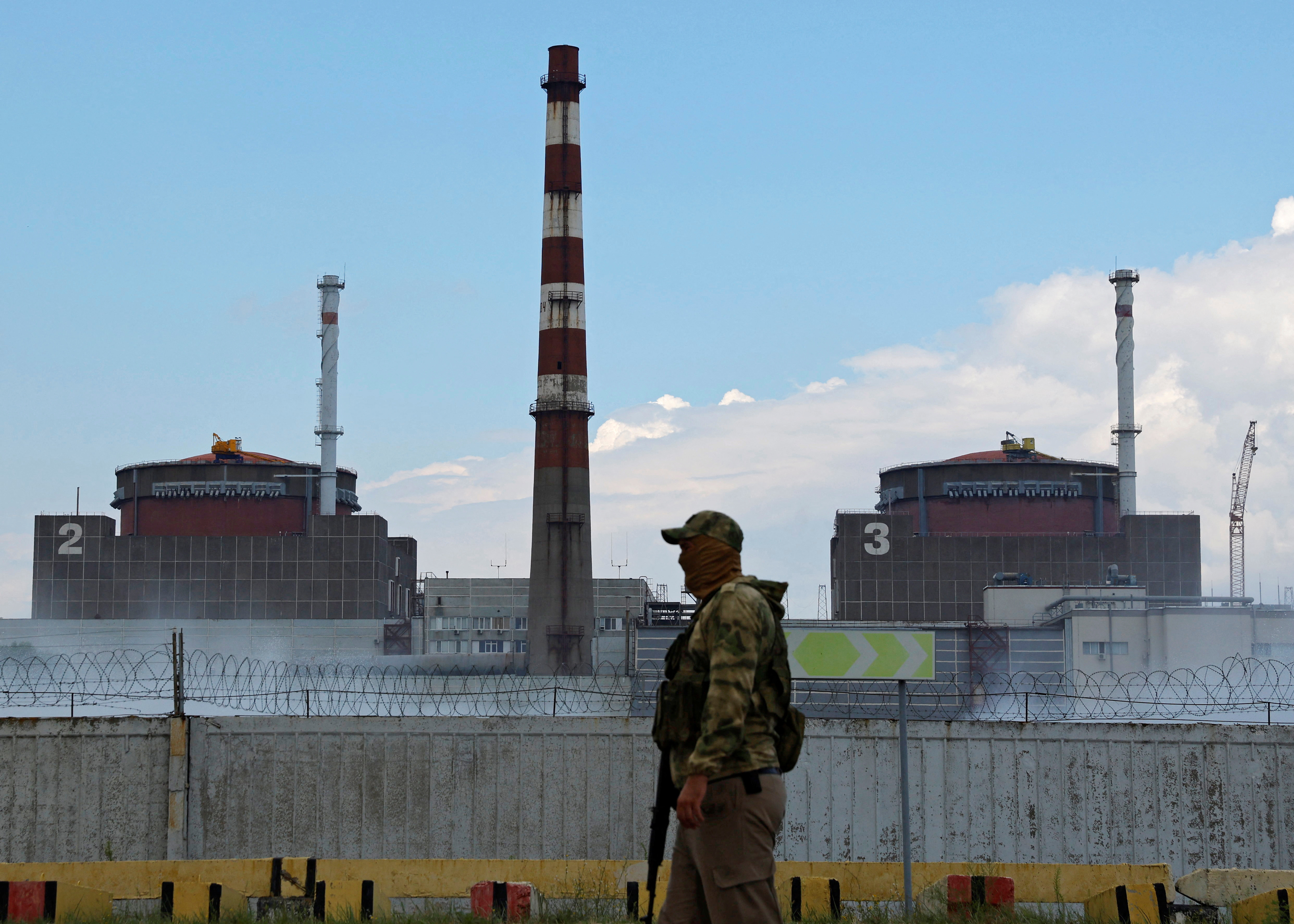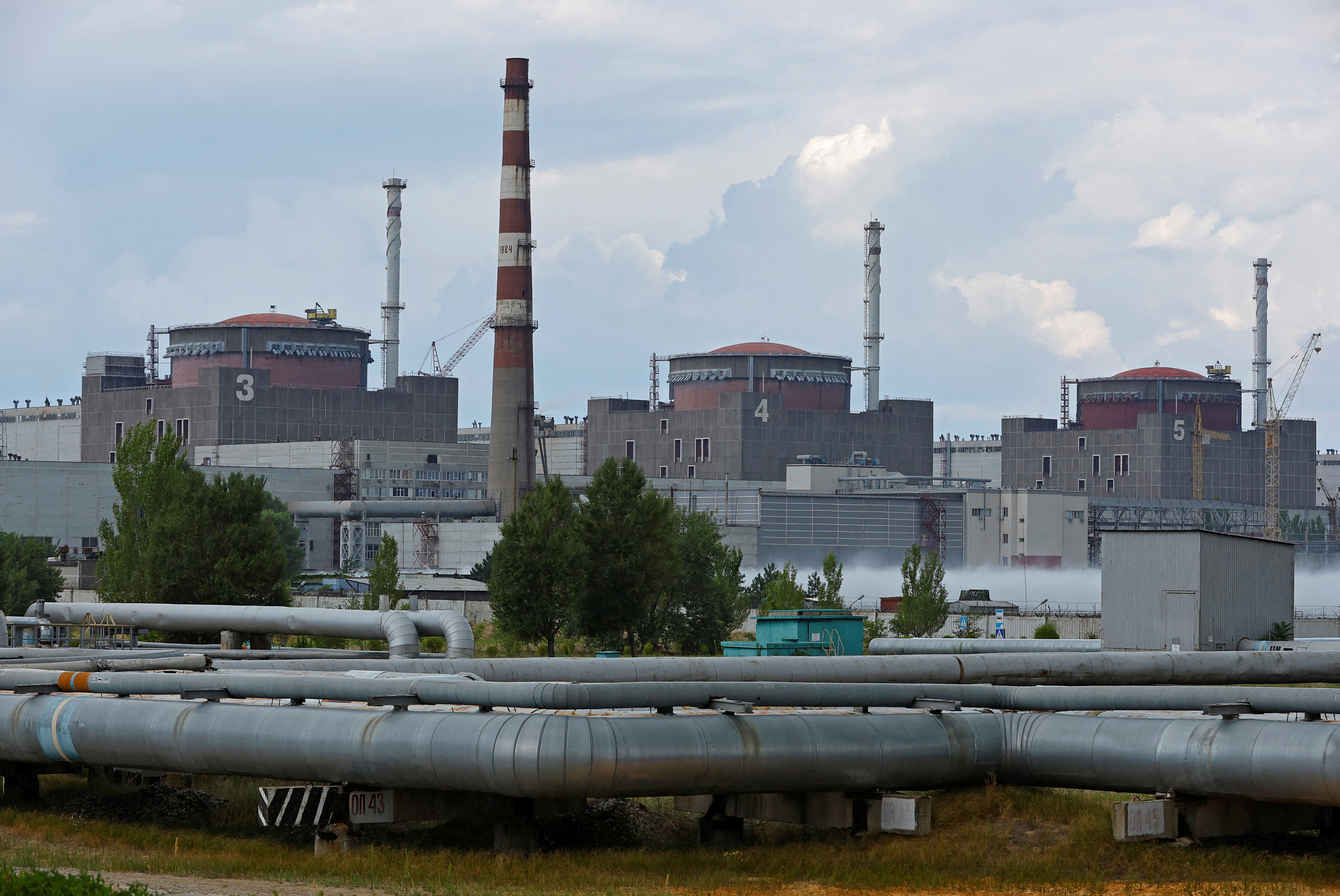
The International Atomic Energy Agency (IAEA) has raised alarms about the shelling that is taking place at the Russian-controlled Zaporizhzhia nuclear power plant in Ukraine, saying the current situation poses a great risk and could lead to a “nuclear disaster”.
Both Russia and Ukraine have accused each other of attacking the plant and of “nuclear terrorism”, with the IAEA urging “utmost restraint” around the site.
Here is what we know so far about the situation.
Where is Zaporizhzhia nuclear power plant and why is it important?
-
Zaporizhzhia nuclear power plant is the largest plant in Europe and among the 10 largest in the world; it generates half of Ukraine’s nuclear-derived power.
- The plant has a total capacity of about 6,000 megawatts, enough for about four million homes.
-
It is located in the southern Ukrainian steppe on the Dnieper River, some 550km (342 miles) southeast of Ukraine’s capital, Kyiv, and about 525km (325 miles) south of Chernobyl, the site of the world’s worst nuclear power plant accident in 1986.
-
Currently, the plant is operated by Ukrainian staff but Russian military units guard the facility.
-
According to the IAEA, the plant has six Soviet-designed water-cooled reactors containing uranium 235, each of which has a net capacity of 950 megawatts. A megawatt of capacity will provide energy for 400 to 900 homes in a year.
-
Zaporizhzhia plant is also located about 200km (125 miles) from Crimea, which Russia annexed in 2014.
-
On Tuesday, Ukrainian operator Energoatom said the Russian forces occupying the area were preparing to “connect the plant to the Crimean electricity grid”.
-
Michael Black, the director of the Centre of Nuclear Engineering at Imperial College London, told Al Jazeera that the main concern is that connecting the plant to the Crimean electricity grid could interrupt the offsite power to the reactors. “You need that power to provide cooling to the reactors … As long as [those generators] function, then everything is fine,” he said.
-
“It’s encouraging to see that the Russians want to use the electricity; that does imply that they don’t want to damage [the power plant],” he added.
What has the IAEA said?
-
Rafael Mariano Grossi, director-general of the IAEA, described the situation as “completely out of control” in an interview with The Associated Press last week.
-
“Every principle of nuclear safety has been violated” at the plant, Grossi said. “What is at stake is extremely serious and extremely grave and dangerous.”
-
During the interview, he said the physical integrity of the plant was not respected and the supply chain was interrupted, so it was not certain the plant was getting all it needs, “and there is a lot of nuclear material there to be inspected”.
-
In a statement released on Tuesday, Grossi said he was preparing to brief the UN Security Council about the nuclear safety in the plant on Thursday and his efforts to agree and lead an expert mission to the site as soon as possible.
-
The IAEA has been trying for months to send an inspection team to the nuclear plant but it has not been successful.
-
The watchdog also said on Tuesday that Ukraine had informed the IAEA about the restoration of a power line that can be used to supply the plant with electricity from a nearby thermal power plant if needed.
-
“This external power line is necessary to safeguard the proper cooling of the facility.
-
Grossi outlined the need for a secure offsite power supply as one of the seven nuclear safety pillars at the beginning of the conflict.
Given the IAEA’s warnings, could the plant explode – and if so – what would happen?
-
According to experts, this is possible but the likelihood of that taking place is not certain.
-
“What we have here with the military involvement is very difficult … If multiple catastrophic factors come together, an explosion might be possible,” Ross Peel, the Research and Knowledge Transfer Manager for the Centre for Science and Security Studies at King’s College London, told Al Jazeera.
-
“It’s difficult to say whether this will [happen] and the possible consequences of that, what they might be. It depends how the explosion comes about,” he added.
-
There are concerns about the shelling occurring around the facility, with the potential to damage critical infrastructure, including the reactors.
-
“Reactors [need] to be constantly cooled by water passing through [them,]” MV Ramana, a professor at the University of British Columbia’s School of Public Policy and Global Affairs, told Al Jazeera.
-
“If that water stream is cut out, cut down, cut off in some fashion, then the reactor could lose cooling, the fuel will start melting. It will sort of create high pressure, and the thing can explode,” he added.
-
In the immediate aftermath of an explosion, experts say that we could likely see widespread evacuations caused by an invisible radioactive cloud. However, the impact of a leak in radiation would probably be felt for years to come
-
“You’re probably going to see hundreds of thousands of people trying to flee from that area,” Ramana told Al Jazeera.
-
“There will be a cloud, but you’re not going to be able to see it … We’re able to track the cloud because [we] have sensitive instruments that are measuring radiation levels,” he added.
-
Some of the illnesses we could see from an explosion similar to this could be acute radiation poisoning or cancers that could be seen later.
-
“So, for instance, at Chernobyl, the people who were going into the reactor to actually stand on top of the burning building and put the fire out were exposed to huge amounts of radiation and suffered the impacts of that within hours,” Ross said.
- “People who are exposed to not quite so great amounts may still suffer from acute radiation poisoning and recover. This happens over days to weeks, maybe months. For people exposed to lower levels of radiation, there may be greater numbers of cancer cases coming later over the following years to decades,” he added.

What other scenarios could take place?
-
Rather than a reactor core explosion, experts are more concerned about damage to systems that cool the spent fuel pool and the reactors. If the cooling fails, this could lead to an uncontrolled heat buildup, a meltdown and a fire that could release and spread radiation from the containment structures.
-
“We’re mostly scared of radiation release, not necessarily of an explosion,” Amelie Stoetzel, a PhD Student in the Department of War Studies at King’s College London, told Al Jazeera.
-
“Even though that looks scary, [a] radiation release, in any case, would be catastrophic,” she added.
-
“It’s unpredictable; we don’t really know where the plume [containing radioactive material] would go; it can go anywhere really, depending on the weather conditions.”
-
Due to the plant’s geographical location, a radiation release could hit any part of the European continent.
-
“Zaporizhzhia is in the middle of the continent. So no matter which way the wind is blowing, somebody’s going to get contaminated,” Ramana said.
-
Overall, experts emphasise that any kind of prediction is hard to make at this stage.
-
“The only certainty we have really is that the military activity around the nuclear power plant poses a risk to it. And how exactly that will play out is, is very difficult to predict,” Ross said.
If there is a radiation leak, what happens next?
-
Experts expect immediate evacuations but also difficulties in accessing medical facilities since they will probably see a surge in patients.
-
“When there were incidents of radiation accidents, there were a lot of people that showed up with symptoms of radiation poisoning, even though they had not been exposed, due to fear and panic,” Stoetzel said.
-
Experts also said that evacuations in a war zone will come with their own set of complications.
-
“A lot of people have already left the area, but there are still a lot of people left behind,” Stoetzel said.
-
“So yes, there would be a lot of people rushing to hospitals and rushing to get out of the area, which would be a problem … there would be confusion; in an ongoing war, evacuating people is extremely difficult,” she added.
-
According to experts, for many people, the fear of radiation could be more dangerous than the radiation itself.
-
“We could see an uptick in patients because of the psychological symptoms that are connected to the knowledge that radiation might have leaked from a nuclear power plant nearby,”
-
“So actually the most problematic issue for the government at least would be how to deal with a large number of patients,” she added.
-
In case of an explosion, or a fire, a leak of radiation could lead to a “long-term disaster”.
-
“It’s not something where people are going to be exposed to it and immediately fall down and die … there’s going to be a huge, psychological toll, right on top of the psychological toll of the war itself,” Ramana said.







